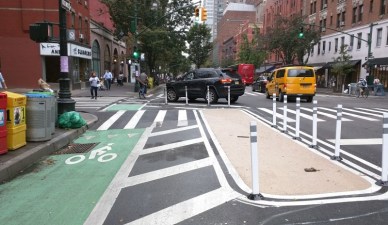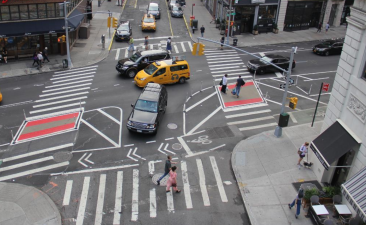A Look at Chicago’s New Intersection Design Where Two Bikeways Cross Paths Downtown

A flaw in NYC’s typical protected bike lanes is that cyclists are too exposed at intersections, where people on bikes are expected to negotiate the same space with turning motorists at “mixing zones.” After Kelly Hurley was killed by a truck driver on First Avenue earlier this year, advocates called on DOT to reconsider mixing zones and implement designs more akin to Dutch “protected intersections,” where drivers are compelled to take slower, tighter turns.
To improve intersection safety for bicycling, the basic goal is to reduce the potential for conflicts between cyclists and turning drivers — with some combination of slowing down turning traffic, making cyclists more visible to drivers, and using signal timing to separate movements that could conflict. These design concepts, which the Dutch have been honing for years, are finally gaining currency in the U.S.
One American city that’s been making progress is Chicago, which is implementing intersections with more robust safety features where bikeways intersect in the Loop. On a recent trip, Clarence Eckerson Jr. made a short Streetfilm of the intersection of Dearborn and Randolph streets, where the new design was completed in 2016:
In New York, the protected bike lanes most in need of attention are on wide, one-way streets with heavy turning traffic across the bikeway — like the intersection where Kelly Hurley was killed. But the same principles have huge potential for bike lanes on two-way streets like Fourth Avenue, where DOT’s proposed redesign includes features to make cyclists more visible to turning drivers.
DOT has created a new staff position dedicated to bikeway intersection design, and the agency says it will be releasing a report on intersection safety for cycling early next year that identifies 20 locations to be upgraded.





